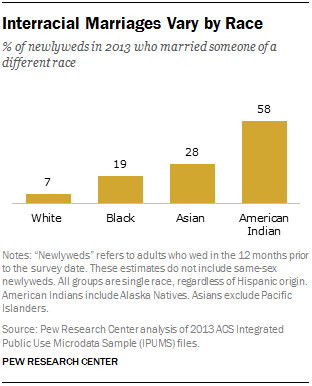The number of interracial marriages has increased 5 times since How many couples that are still married today are interracial? What percentage of African Americans marry someone of a different race? What percentage of whites marry someone of a different race? What percentage of Asians marry someone of a different race? What percentage of Hispanics marry someone of a different race? Hispanics come in second as the most likely to marry outside their ethnicity. What is the most common racial pairing today among newlywed couples?
- free dating sites kerry?
- Interracial marriage: Who is ‘marrying out’?.
- What's behind the rise of interracial marriage in the US? | Life and style | The Guardian.
Today , the most common interracial pairing is one Hispanic spouse and one white spouse. Which state has the highest number of interracial newlyweds? Hawaii has the largest number of interracial newlyweds today.
Key facts about race and marriage in the U.S.
When did the ban on interracial marriage end? The ban on interracial marriage ended with the decision of Loving vs Virginia on June 2, What percentage of recently married black men have a spouse of a different race? African American men have a higher likelihood of marrying outside their race. What percentage of recently married black women have a spouse of a different race?
African American women are less likely to marry outside of their race. What percentage of nonblack adults oppose a relative marrying a black person today? Today 's society is much more accepting of interracial marriage.
Race and Attraction, 2009–2014
What percentage of people with just a high school diploma marry someone from a different race? What percentage of people with a college degree marry someone from a different race? Best Online Dating Site.

How many infants today are biracial? What percentage of the population is biracial? According to a study conducted by Pew Research, 6. This is slightly elevated from the estimate provide by the Census Bureau, but the study takes into account the heritage of each adult, not just their self-reported race.
Top Navigation
What is the racial breakdown of the U. As of the latest census, the racial breakdown in the U. What percent of interracial couples end up in divorce? What percent of same-race couples end up in divorce? This poll is the latest comprehensive survey of U.
- dating website overweight;
- Interracial marriage: Who is ‘marrying out’? | Pew Research Center;
- Interracial marriage in the United States.
More than one-third 38 percent of black students had dated a Hispanic, while 10 percent of black students had dated an Asian student. Teens surveyed also had an overwhelmingly positive view of interracial dating. But the Gallup survey also found that teens thought some interracial couples—always involving a black partner—faced potentially greater friction from their respective racial and ethnic groups about their relationships.
For example, while no more than 11 percent of the teens surveyed thought a white-and-Hispanic or white-and-Asian couple would be ostracized by their respective racial or ethnic groups, about one-quarter of those surveyed said that a white and a black student dating each other would face problems from other white or black students in school.
Among students who had dated interracially, at least 90 percent each of white, Hispanic, or Asian students said their parents acquiesced to their relationship. But only 59 percent of black students who had interdated said their parents were comfortable with their dating.
Ludwig and Yancey both agree that interdating is unlikely to increase significantly over the coming decade. Only about one-quarter 24 percent of the teens surveyed by Gallup thought the United States would be better off if more people interdated, while 9 percent thought the country would be worse off. However, the largest share—67 percent—thought an increase in rates of interdating would make no social difference at all. In a country that eliminated its antimiscegenation laws less than 50 years ago, perhaps this indifference is the most positive sign yet of progress in U.
The Youth Connection While Yancey studied interdating habits among adults, the future of interdating can perhaps best be understood by studying the activities and attitudes of teenagers. Racial Differences in Interdating Patterns But the Gallup survey also found that teens thought some interracial couples—always involving a black partner—faced potentially greater friction from their respective racial and ethnic groups about their relationships.
